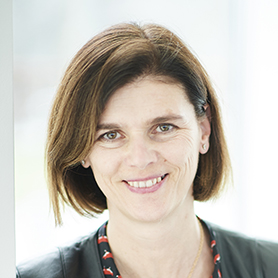Annemie Godts: We have to change the way we work
Since starting her career as a bio-engineer, Annemie now combines her experience in health, safety, the environment and stakeholder engagement to enrich her current Europeanwide responsibilities. Here, she talks to dss+ on what it takes to achieve sustainability goals and explains her view on the 3 Ps model - People, Planet and Profit.

It’s often said that good company culture and leadership are vital to reaching sustainability goals, but are they enough?
I think good company culture and leadership are the starting points. But it’s also important to remember that, first and foremost, a company is created with people that are there to drive the company forward. So sustainability targets have to really touch everyone and people have to embody what the company stands for. Increasingly, having a diverse and inclusive workforce is becoming an essential driver in creating sustainable value. I think we are beginning to learn that if we don’t focus on creating diversity across every level of the organisation, it will continue to be “more of the same” ideas. We are also beginning to learn that developing a sustainable business requires a more creative approach to onboard fresh ideas and sometimes take things in a new direction. An important enabler to achieve this, besides diversity, is creating an inspiring work environment where people can continuously grow, learn and develop, but where there is also room for reflection and contemplation.
Technology and innovation are becoming essential tools for creating a sustainable business. Yet, with so much choice, how can organisations decide on the right approach?
It’s all about connecting the right technological solutions to the task. Without proper consideration, we risk people drowning in technology, which can create new risks. We need to remember that human interaction is still an essential tool in the workplace as it’s crucial to people’s wellbeing and how they feel on the job. So it’s vital to be clear that we are using technology as an enabler to make the working environment safer, efficient and more sustainable. Having a clear strategy on technology and innovation is essential.
Can you explain more about the benefits of allowing time to reflect on sustainability ideas and how that works on a practical level?
Quite often, an organisation’s primary focus is understandably on daily business goals and targets, but sometimes taking time to reflect in broader groups can uncover new ideas on sustainability. Providing a place where ideas can be discussed and challenged can spark new ways of tackling an issue. It moves away from a prescriptive approach to one where concepts can be nurtured organically and allowed to progress. At a practical level, the whole organisation should be represented from management to the finance department to the shop floor. At the same time, people need to be clear on the group’s purpose and how each person can contribute so that everyone is moving in the same direction. Finally, leadership has to listen, engage and implement ideas and solutions that emerge from these group discussions.
"I think we are beginning to learn that if we don’t focus on creating diversity across every level of the organisation, it will continue to be “more of the same” ideas."
How do you see Operational Excellence playing a role in creating a sustainable business, particularly regarding health and safety in the workplace?
Health, safety and sustainability are closely aligned, but the balance needs to be correct. On the one hand, we need to support the business’s sustainable goals with operational excellence. But we also need to challenge health and safety behaviour, so the business progresses on a more sustainable path. Here leadership plays an essential role in allowing people to take ownership of health and safety for themselves and their colleagues. Thankfully we are gradually moving away from focusing on avoiding health and safety incidents to a more forward-looking and sustainable approach that looks at the positives of changing behaviour and culture. It’s about creating a non-judgemental culture that allows people to speak up openly about near misses or dangerous situations so that people can learn from mistakes and move forward. This is fundamental to operational excellence. By creating a channel to capture ideas and providing an open forum, people feel listened to and appreciated for what they do and the value that they bring to the company. It’s about creating a culture where everybody can contribute, so an organisation operates in a sustainable and safe working environment.
"We have to change the way we work, the way we live and the way we consume. This was very evident during the pandemic when we became more aware of the environment and the human need to connect socially."
COP26 was an important milestone in tackling climate change. What would you say are the current challenges on moving to a low carbon and more sustainable future?
While there’s undoubtedly a sense of urgency and recognition that we can no longer ignore what is a global problem, the challenge will be to get firm decisions made and action taken. Yet, we can only achieve sustainability if we all act together. Like the 3 Ps model, everyone has to play their part - governments, businesses and individuals. We have to change the way we work, the way we live and the way we consume. This was very evident during the pandemic when we became more aware of the environment and the human need to connect socially. Understanding these connections will be vital in achieving a sustainable future for all.
"Businesses have a substantial economic role in providing employment and helping economies flourish. Companies can only do this if they perform well and make a return on their investments."
Tell us more about the 3 Ps - People, Planet and Profit - model and, in particular, how profit is part of the sustainable story?
It’s a simple model that cuts through the complexity of navigating sustainability in business. First, creating a sustainable business is about the people who work within an organisation, the wider supply chain, and the local community. It’s also about preserving and taking care of the planet for future generations to come. On the other hand businesses have a substantial economic role in providing employment and helping economies flourish. Companies can only do this if they perform well and make a return on their investments. So it’s a combination of all three of these pillars that achieves sustainable goals in a sustainable way. But it’s not a quick fix and requires a long term strategic view.

